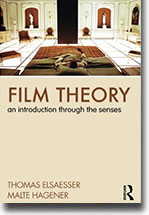 Film Theory: An Introduction Through the Senses might be described as a neo-Deleuzian examination of film and visual media. It’s a good book, using metaphors to look at film, such as “film as a window” or “cinema as brain” and this seems a Deleuzian way of going about it.
Film Theory: An Introduction Through the Senses might be described as a neo-Deleuzian examination of film and visual media. It’s a good book, using metaphors to look at film, such as “film as a window” or “cinema as brain” and this seems a Deleuzian way of going about it.The book is mostly a phenomenological approach, informed by cognitive approaches a little bit on the side. It deals mostly with the reception of film, rather than the medium and production aspects, so in a sense, it doesn’t get far beyond “appreciation” but it does open one’s eyes to new ways of thinking and understanding the cinematic experience. It really should have been called “cinema theory” because it’s less about “film” and more about “visual culture” and “cinema” as an experiential event.
Film Theory possesses a robustness to match its sophistication, and an approach that feels as though it has been road-tested. This book stands a very good chance of wide adoption in introductory film studies courses, as preparatory reading, or as a text to be worked through chapter by chapter, supplemented by close analysis of the theories at issue, and screenings of the films discussed. The combination of sophistication and robustness should ensure that it will prove effective both at undergraduate and at graduate level.
With admirable concision, Elsaesser and Hagener’s book manages intelligently and insightfully to use its own new and unique framework to cover virtually all of film theory, suggest the schools it divides into and their stakes, and to relate this to film history, to broader philosophy, and to transformations that film is undergoing in the age of the digital.
Each chapter begins with a succinct sequence analysis that provides a foundation for the theoretical discussion that follows. Instead of foregrounding the theory and then “applying” it to the film, the authors invite the student to refer back to the film as the chapter progresses, critically considering how the practical enunciation of key theoretical concepts might (or might not) occur.
The authors argue that this act of reflection should not terminate with the film that prefaces each chapter, but rather should inspire the student to draw connections between the theory and other films they have previously seen. This productively encourages the student to familiarize itself with theory by connecting it to his or her own larger framework of experiences with cinema.
Authors: Thomas Elsaesser and Malte Hagener